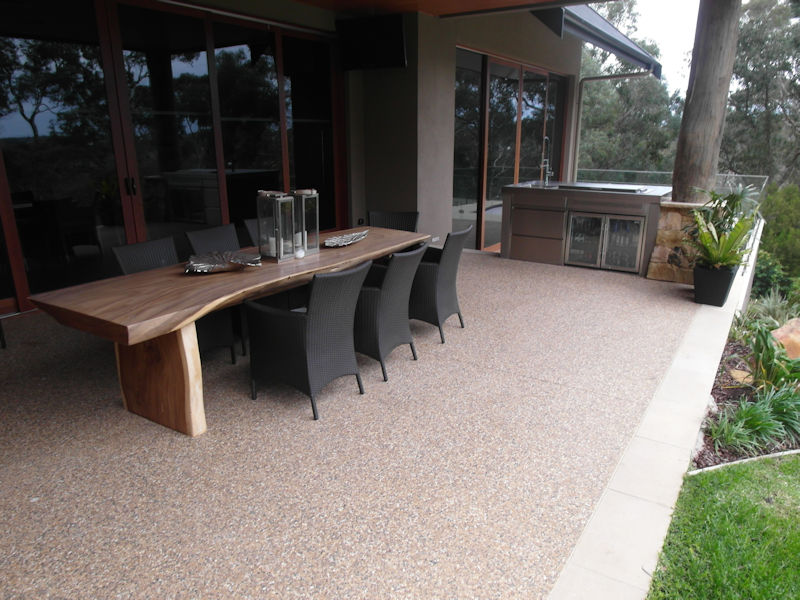Imagine yourself on a warm summer evening, relaxing on your patio with a cool drink in hand, the scent of barbeque wafting through the air, and the sound of laughter filling the space. A well-designed patio is an extension of your home, a place for gathering, entertaining, and enjoying the outdoors. But one crucial element that can truly elevate your patio’s ambiance and functionality is the right flooring. With endless options available, choosing the perfect patio flooring can feel overwhelming. What are the best materials to ensure durability, style, and a comfortable outdoor experience?

Image: johnganjelrel.blogspot.com
This guide will explore the various types of outdoor patio flooring, their pros and cons, and provide insights to help you make an informed decision. We’ll dive into the world of wood, stone, concrete, composite decking, and more, uncovering their unique strengths and weaknesses to help you find the ideal material that aligns with your needs and vision.
Types of Patio Flooring: A Comprehensive Guide
The perfect patio flooring material depends on several factors, such as your budget, desired aesthetic, and the intended use of the space. Below, we discuss the most popular options, their characteristics, and what makes them stand out.
1. Hardwood Decking
Hardwood decking is a classic choice for patios, offering timeless warmth and an elegant feel. Popular hardwood options include:
- Ipe: Highly durable, resistant to rot and insects, and boasts a rich, dark color.
- Teak: Renowned for its natural oil that repels moisture and adds durability, naturally aging to a silvery gray.
- Cedar: Known for its natural insect-repelling properties and aromatic scent, offering a warm, reddish hue.
Pros:
- Natural beauty and elegance
- High durability and longevity
- Warm underfoot feel
Cons:
- High cost, especially for exotic hardwoods like Ipe and Teak
- Requires regular maintenance, including staining and sealing
- Can be prone to warping or cracking in extreme temperatures.
2. Composite Decking
Composite decking, a blend of wood fibers and recycled plastic, has become a popular choice for patio flooring due to its durability and low maintenance.
Pros:
- Low maintenance requirements
- Resistance to fading, staining, and moisture
- Wide range of colors and styles available
- Environmentally friendly due to recycled content
Cons:
- Can sometimes feel less natural than real wood
- Can become hot underfoot in direct sunlight
- May fade over time, though this can be minimized with regular cleaning.

Image: thisisedit.co
3. Natural Stone
For a timeless and sophisticated look, natural stone flooring is unmatched. Popular options include:
- Granite: Extremely durable, scratch-resistant, and available in a variety of colors and patterns.
- Slate: Offers a unique texture and natural variations, available in a wide color range.
- Limestone: Adds a classic, elegant feel with a subtle, warm tone.
Pros:
- Natural beauty and unique patterns
- High durability and longevity
- Resistant to fading and weathering
Cons:
- Can be expensive, especially for larger patios
- Heavy and requires professional installation
- Can be slippery when wet, requiring extra care.
4. Concrete
Concrete flooring provides a sturdy, budget-friendly option for patios. Its versatility allows for a wide range of finishes and colors, including stamped concrete, stained concrete, and decorative overlays.
Pros:
- Affordable and durable
- Versatile in design, allowing for a variety of finishes and colors
- Low maintenance requirements
Cons:
- Can be porous and require sealing to prevent staining
- Can feel cold underfoot, which can be mitigated with rugs or mats
- Cracking can occur over time if not properly installed or maintained.
5. Pavers
Pavers offer a versatile and customizable option for patio flooring. Made from various materials like brick, stone, concrete, or even recycled materials, pavers allow you to create unique patterns and designs.
Pros:
- Wide array of materials and colors to choose from
- Easy to install and repair
- Allow for drainage and prevent water pooling
Cons:
- Can be more expensive than concrete
- Spacing between pavers can sometimes collect dirt and debris
- May sink or become uneven over time, requiring periodic maintenance.
6. Tiles
Tiles are a popular choice for patios, offering a variety of materials and designs, including porcelain, ceramic, and natural stone.
Pros:
- Resistant to moisture and weathering
- Wide range of colors, textures, and patterns
- Can be relatively easy to install and maintain
Cons:
- Can be more expensive than other options, especially for high-end materials
- Can become slippery when wet, especially some smooth tile types
- Can crack under heavy impact
Choosing the Best Flooring for Your Patio
Now that you have a better understanding of different patio flooring options, consider these factors when making your decision:
- Budget: Determine what you are willing to invest in flooring, as costs vary significantly between materials.
- Style: Choose a style that complements your home’s architecture and personal preferences.
- Climate: Take your local climate into account, considering factors like temperature extremes, rainfall, and humidity.
- Maintenance Level: Assess your willingness to invest time in upkeep. Some materials require more maintenance than others.
- Intended Use: Consider the frequency of use and activities on your patio. A high traffic area might require more durable materials.
What Is The Best Flooring For An Outdoor Patio
Conclusion
Selecting the best flooring for your outdoor patio is an important decision that can impact both functionality and aesthetics. By carefully considering various factors and analyzing the pros and cons of each material, you can make an informed choice that meets your specific needs and preferences. Whether you prefer the timeless elegance of hardwood decking, the durability of composite, the sophisticated style of stone, the affordability of concrete, or the versatility of pavers, there is an ideal flooring choice waiting to transform your patio into a delightful outdoor oasis.






